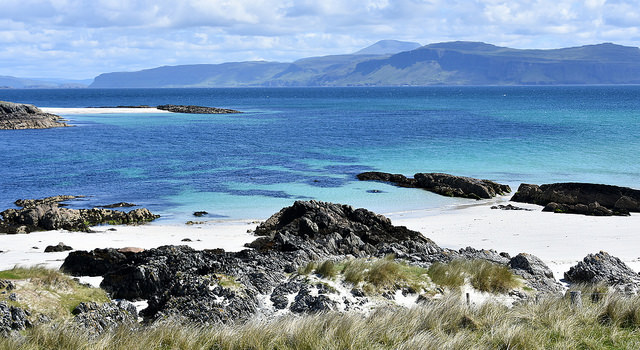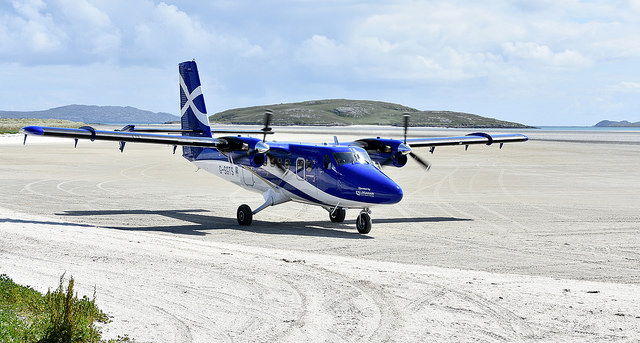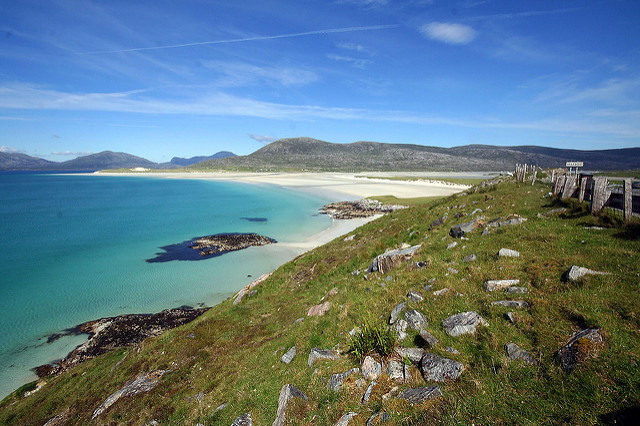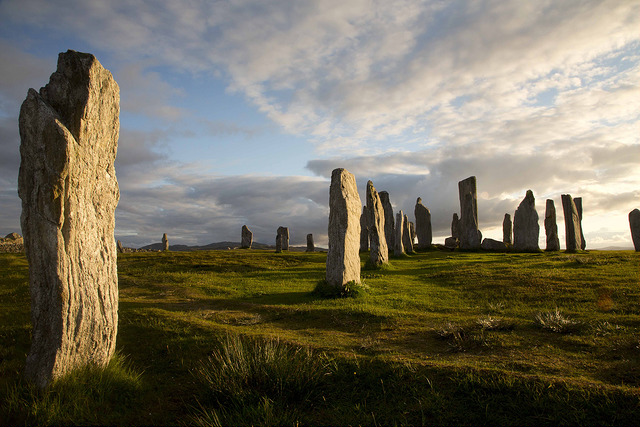The Outer Hebrides (also known as the Western Isles, Outer Isles or the Long Island) are one of the most beautiful parts of Scotland, with white sands, turquoise seas and very few people. Life moves at a slower pace here, especially on Sundays, and the roads are quiet. The weather’s not always reliable, but this is Scotland’s Wild West, with climate to match.
Some of the islands are connected by bridges now but you’ll still need ferries to get out to the Isles and between them. The most cost-effective way to do this is to buy a Hopscotch ticket from Caledonian MacBrayne (better known as CalMac), who operate almost all the ferries around the west coast of Scotland.
A Hopscotch ticket allows you to travel for 31 days from the date of your first ferry trip and you can use it to go in either direction between the islands. It doesn’t guarantee you a place on a particular sailing (booking in advance is highly recommended during busy periods) nor does it save you money, but once you’ve bought your ticket you don’t need to shell out again, which makes budgeting easier.
The other vital piece of equipment for your Hebridean trip is midge repellent. The islands are a stronghold of the Highland midge, which prefers human blood to all other forms of sustenance. A hat helps keep the little blighters out of your hair, but you’ll need to slather all exposed skin in repellent. Legend has it that Avon’s Skin So Soft moisturiser is the most effective (and that this fact was discovered by the Marines!) but there are plenty of others to choose from. You can check out the current ‘midge forecast’ here: https://www.smidgeup.com/midge-forecast/
Some basics

The northern Outer Hebrides (Lewis, Harris and North Uist) are largely Protestant, and you will find most shops and pubs are shut on Sundays and ferries do not run on the Sabbath except on very rare occasions when the weather has caused sailing delays and small island shops are running out of food. The southern islands (Barra, South Uist and Benbecula) are largely Catholic and Sunday traditions are more relaxed here.
Gaelic is still spoken by many Hebridean islanders and road signs are in both Gaelic and English. It’s quite fun trying to work out how to pronounce Gaelic place names by reading the English and seeing how many letters are “left out”.
Most ferry terminals have black-water emptying facilities, toilets and showers, though you may have to hunt for them. Some also offer good long-term parking if you want to spend a day in town.
Wild camping is allowed but it’s always worth asking permission of the local crofter(s). And please don’t park on the machair: it’s both legally protected and easily damaged. Machair means a fertile low-lying grassy plain in Gaelic and it’s one of the rarest habitats in Europe, occurring in the Outer Hebrides and nowhere else. It is very rich in wildflowers, birds and insects and the locals are understandably protective of it.
Mull and the Inner Hebrides
The classic Hebrides trip starts at Oban, with the ferry to Craignure at the south-eastern tip of Mull, in the Inner Hebrides. If you have time, a drive round Mull is very rewarding. You can take the short ferry trip from Fionnphort at the south-western tip of the island across to the early Christian sites on Iona, which offers peaceful walking and biking. Don’t take your motorhome across: go as a foot passenger and return to your van on Mull in the evening.
If you travel up the west coast of Mull, you’ll see signs offering boat trips to Fingal’s Cave on Staffa, which inspired Mendelssohn. Its basalt columns are part of the same geological formation as the Devil’s Causeway in Northern Ireland and the acoustics are very distinctive. The island, now owned by the National Trust for Scotland (NTS), is also a Site of Special Scientific Interest for its wildlife.
Starting on Barra
From the famously painted waterfront of Tobermory you sail to Castlebay on Barra, the most southerly of the Outer Hebrides. The bay takes its name from Kisimul Castle, home of the MacNeils since the 11th century. There’s also a community-run shop, Buth Bharraigh, which stocks local crafts as well as food and drink.
From Barra there’s a causeway to Vatersay, with its abandoned village of Eoradail and abundant wildflowers in the machair.

Back on Barra, you’ll find seals at Seal Bay and, at Traigh Mhor at the northern tip of the island, the famous Barra airport. It’s the only airstrip in the world where scheduled flights land on the beach and are determined by the tide table. There’s an excellent airport café, open to non-flyers as well as passengers.
Nearby you’ll find the small Croft Number 2 Caravan and Camping site, which sits within 50m of the beach and has all modern conveniences for motorhomes, including a drying facility. It’s handily open all year.
South and North Uist, Benbecula and Berneray
From Ardmhor, near the airport, you catch the ferry to the small island of Eriskay, from which there’s a bridge to South Uist. There’s plenty to do here, whether you want to follow the Bonnie Prince Charlie trail, look out for golden and white-tailed sea eagles, grey and common seals and bottlenose dolphins, or check out the sweater-makers of Eriskay Jerseys. There are plenty of mapped walks and cycle routes to follow and, of course, there’s machair everywhere. If you prefer to see the sea, you can take a boat trip from Lochboisdale with Uist Sea Tours.
There are campsites at both Lochboisdale and South Lochboisdale that cater for campervans. There’s nothing at the north of South Uist, but Benbecula offers the Shellbay Caravan and Camping Park at Liniclate.
North Uist has many monuments and ruins for lovers of ancient history. The Udal Peninsula is one of the most important archaeological sites in the UK, having been occupied from Neolithic times to the early 20th century. Eilean Domhnuill is an artificial island in Loch Olabhat that also dates back to Neolithic times; there’s another stronghold in the middle of the tidal loch of Sticir, connected by stone causeways to the mainland.
If history’s not your thing, follow the Bird of Prey Trail to see hen harriers, merlins and short-eared owls, which forage in daylight, or take a walk across to uninhabited Vallay Island at low tide – make sure you get back before the tide cuts you off! At Malacleit, at Traigh Bhalaigh (Vallay) on the north coast of North Uist, you’ll find a typically peaceful crofting village. You can also follow the Uist Sculpture Trail or sections of the Hebridean Way on foot or by bike.
From Lochmaddy you can take a CalMac ferry back to Uig on Skye and head home if you’ve run out of time. But there’s plenty more to see and do in the Western Isles first.
At the southern end of Berneray, for example, you’ll find the monument to Aonghas Mor MacAsgaill, better known in English as The Giant MacAskill, who spent most of his life in Cape Breton, Nova Scotia, and apparently topped out at 7’9” – the “world’s largest giant”. He was nearly as tall as the standing stone at Cladh Maolrithe, which is 8’ tall – at least the bit that you can see. The part underground is said to be just as big.
Harris
From Berneray you take the ferry across the Sound of Harris, with views over the Atlantic towards St Kilda, and land at Leverburgh at the south end of the Isle of Harris. It’s really the same island as Lewis, but there are geological and cultural differences between the two that make them feel completely different. The ancient rocks of the east coast of Harris, some of the oldest in the world, stood in for Jupiter in Stanley Kubrick’s “2001, A Space Odyssey”.
You can walk and cycle your way round Harris on several well-laid out mapped routes. Or you could take a day-trip to St Kilda or the Shiant Islands, weather permitting, or discover maritime history at the old whaling station at Bunavoneader and the first lighthouse in the Western Isles on Scalpay. St Clements Church, at Rodel, is also worth a visit. Dating from the 1520s, it has a surprisingly large tower and a peaceful, if scattered, graveyard.
Wildlife you might see includes otters, seals, porpoises, red deer, golden and sea eagles, hen harriers, golden plover and even corncrakes (though you’re more likely to hear those than see them). If you go in June, look out for the golden flowers of bog asphodel on the moors.

But many people go to Harris for the beaches: Luskintyre, Horgabost, Huisinis (Hushinish) and the others all boast miles of pure white sand and sea that could be Caribbean … until you dip a toe in. Some hardy folk come to the Hebrides to surf – the waves roll in from America with nothing to stop them – but it’s not a place for the casual board-rider. The sea provides some challenging fishing, too.
Then, of course, there’s the world-famous Harris Tweed. You can watch it being made at the Harris Tweed Exhibition at Drinshader, or buy it from the official shop and warehouse in Tarbert. Tarbert is also home to the island’s first distillery, which also has a canteen serving local food. The distillery produces both whisky and gin with a distinctly maritime flavour, and is very much a local and social enterprise.
Lewis

Without doubt, the most famous thing on Lewis is the Callanish (Calanais) standing stones, one of the most complete sets in Europe and, unlike Stonehenge, not fenced off. Dating back some 5,000 years, they’re also earlier than Stonehenge, and the rock they’re made from (Lewisian Gneiss) dates back some 3000 million years. They’re particularly atmospheric at or just after dawn and dusk. There are three other stone circles nearby, prosaically named Callanish 2 (Cnoc Ceann a’Gharraidh in Gaelic), Callanish 3 (Cnoc Fhillibhir Bheag) and Callanish 4 (Ceann Thulabhaig).
Dun Carloway Broch, one of the best preserved brochs in Scotland, is about 5 miles from Callanish. It’s a double-walled stronghold with a staircase between the two walls and dates from the early Iron Age. At Great Bernera (not to be confused with the island of Berneray), there’s a reconstructed Iron Age house, excavated from the sand after a storm. The beach here is worth the detour by itself.
Further up the coast you’ll find the Arnol Blackhouse, a traditional straw-thatched house with no chimney (so the fire’s smoke blackened everything inside, where both humans and livestock lived. The walls are made of mortarless stone and the floor is just bare earth. Houses like this one were in use right up ‘til the end of the 19th century. Between Great Bernera and Arnol are the Norse Mill and Kiln, reflecting the Viking influence on the region.
Two places on Lewis are particularly good for spotting basking sharks: the Port of Ness and Mangersta Head. The best time to see these huge plankton-feeders is July and August as they trundle through the water, mouths agape for their tiny prey.
Also in July, you’ll find the Hebridean Celtic Festival in the Western Isles’ capital, Stornoway. It’s a family-friendly event showcasing all types of Celtic music in large and small concerts and free events all over town. Stornoway also produces famously good black pudding and is the ferry port from which you return to the mainland, landing at Ullapool.
You’ll find Celtic traditions celebrated all over the islands all year by the craft-makers who live there, selling their work either from their studios or through shops. Their works reflect the light and colours of the islands, their peacefulness and storms, and make unique souvenirs of your trip to Scotland’s Wild West, the Outer Hebrides.